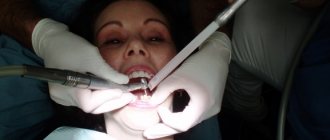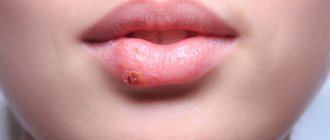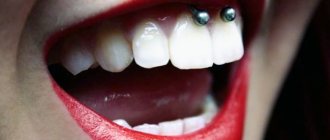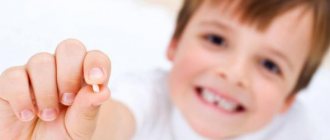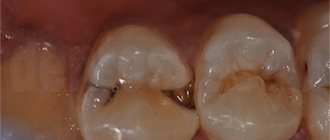The upper lip frenulum is a small membrane of mucous membrane that is located in the oral cavity above the upper incisors between the lip and gum (see also: how is the upper lip frenulum trimmed?). Normally, it begins 5-8 millimeters above the incisors and then weaves into the lip. If it is attached lower or the beginning of the attachment is not visible at all, then such a frenulum is considered short. Below are the most common problems associated with a pathologically short labial frenulum:
- violation of diction;
- formation of malocclusion;
- frequent injury;
- difficulty for the baby when breastfeeding;
- periodontal diseases, the occurrence of tooth instability;
- diastema formation;
- inflammation of the gums;
- the appearance of a periodontal pocket due to tension by the mucous band of the gums.
How to determine that a child has torn or torn the frenulum?
Injuries to this part of the oral cavity are common. Children are very active; when they climbed up the slide, they fell and as a result they tore the mucous cord. What to do? Mothers, of course, are concerned about this, because teeth are what adorns the baby’s cute face. In this case, there is no cause for concern - this incident does not threaten life. If the short frenulum is torn, you need to show the child to a dentist, but first, let’s figure out what the signs of injury are: (see also: what to do if the child has a very short frenulum of the upper lip?)
- bleeding in the area of the upper lip (can be profuse with a large cord);
- redness;
- edema;
- soreness;
- against the background of stress, a small child may have a slight rise in temperature.
First aid
It is very important to provide first aid correctly:
- The main rule is not to panic. Calm the child and calm yourself, the second is most preferable, because an excited mother can make a lot of mistakes.
- If there is massive bleeding, apply cold (something from the refrigerator) to the lip, but not for long, intermittently.
- After stopping the bleeding, you need to rinse your mouth with any antiseptic (herbal decoctions, Furacilin, Chlorhexidine, Miramistin).
- For children who, due to their age, are not able to rinse their mouths on their own, the mother should treat the wound with a cotton swab dipped in a decoction of herbs. For this, herbs such as St. John's wort, chamomile, and sage are used.
- After all the procedures performed, be sure to visit a doctor. The doctor will conduct an examination, assess the extent of the damage and prescribe further treatment if necessary.
What to do and how to remove the defect?
Medicine does not stand still. Nowadays, doctors offer several ways to correct the frenulum. The baby who tore it will undergo appropriate plastic surgery. There is plastic surgery using a scalpel, gum scissors, and a new method of removal - laser. The doctor decides which method is best to resort to. Any procedure has its own indications and contraindications. This is discussed with a specialist.
Laser frenulum removal is an innovative method. It has a lot of positive reviews not only from doctors, but also from patients.
There are methods that have proven themselves to be positive over the years:
Procedure
| Description | |
| Frenotomy | The frenulum is cut vertically and sutured horizontally. |
| Frenectomy | The method is most suitable for large strands. It is cut along its entire length, and then the interdental papilla and all excess tissue are removed. |
| Frenuloplasty I | The frenulum is cut with a scalpel or scissors. A diamond-shaped defect remains. For mobilization, the edges close to the incision of the mucous membrane are excised and, using a raspator, brought closer to the periosteum, closer to the formed vestibule. Then everything is sutured. |
| Frenuloplasty II (according to Limberg) | A vertical incision and two oblique ones are made in the center of the frenulum. Triangular flaps are formed and mobilized. Then they are fixed taking into account that the central cut is located horizontally. It is sutured with interrupted sutures. |
How long does it take for the frenulum to heal after surgery?
When using a scalpel or scissors, silk sutures are placed at the end of the procedure. They are removed on days 5-7. But there are times when you need to walk around with the strings longer. It all depends on the characteristics of the body and the care of the postoperative wound. After the laser there are no stitches, but the care is the same. It consists:
- in maintaining oral hygiene;
- in optimizing the diet - food should be homogeneous and at the optimal temperature;
- in performing special gymnastics, which is prescribed by the doctor to develop the muscles involved in chewing and facial expressions.
At the age when children begin to walk independently and explore the world, injuries often happen to them. If, while falling, he does not have time to protect himself with his hands and hits his face, this leads to maxillofacial injuries. The mother will understand that the child has torn the frenulum on the upper lip by bleeding, his state of shock, and screaming.
Stages of implementation
At the initial stage, a comprehensive examination is carried out to identify the form of the pathology, establish the presence of contraindications, and also draw up a treatment plan, which is agreed upon with the patient or his parents. The oral cavity is also sanitized, which is necessary to eliminate infectious foci.
The frenuloplasty operation is performed using general anesthesia using one of the following methods:
- Y-shaped - involves dissecting the frenulum with a scalpel or scissors, followed by advancement of the edges of the mucosa into the vestibule, which avoids tissue tension;
- Z-shaped - making a longitudinal incision with two diagonal branches, after which the resulting triangular-shaped flaps are attached with sutures in the periosteum area.
The surgical intervention takes no more than half an hour, and in some cases allows you to eliminate a previously formed diastema - due to pressure from the lateral incisors.
Functions of the frenulum of the upper lip
There are 3 frenulums in the human mouth, one is located under the tongue, 2 connect the upper and lower lips with the oral cavity. These are small mucous formations that affect the anatomy of the smile, bite, pronunciation of sounds, and they help babies latch onto the breast. If a newborn has a short or thick frenulum of the upper lip, he cannot latch onto the nipple correctly and as a result will refuse breastfeeding in favor of bottle feeding. In this case, it is trimmed in the maternity hospital, eliminating the problem.
The bridge between the lips and palate influences the formation of the child’s bite. Due to its deformation or irregular structure, defects in the dentition occur: protrusion of the front incisors forward. Such a nuisance is likely in rare cases, if the baby has permanent teeth rather than baby teeth. The problem is severe and requires long-term, expensive orthodontic treatment.
A short frenulum during chewing and talking pulls back the gums, which exposes the neck of the front teeth, creating conditions for the development of caries, periodontal disease and other pathological processes, complicating oral hygiene. This defect is diagnosed and eliminated. The anatomical position of the bridge is characterized by its base at a level of 0.5-0.8 cm from the neck of the incisors; if it is localized below, observation and treatment are required to eliminate the possibility of it breaking.
Trimming is carried out only when the front incisors are erupting, so that the pressure from other permanent teeth naturally closes the diastema. A short bridge between them increases the likelihood of injury; it has happened that a child’s frenulum of the upper lip has torn due to excessive tension due to a blow.
First aid
The international classification of diseases ICD-10 classifies the short frenulum not as a disease, but as an anatomical feature of intrauterine development, and assigns code Q38.0 “Congenital anomalies of the lips.” A rupture of the child's upper lip frenulum requires parents to perform several assistance procedures before the ambulance arrives.
- Rinse the injury with cold or cool boiled water, and if possible, inspect where the tissue may have been torn.
- Stop the bleeding. Every home medicine cabinet contains a bottle of hydrogen peroxide, which can clog blood vessels and stop capillary bleeding. Soak a piece of bandage, a cotton pad or a cotton swab with peroxide and apply it to the damaged area. The child may be frightened by the rapid formation of foam; you should be patient, take him in your arms, and calm him down. Ice or frozen foods in the freezer will help cool the area of the tear, stopping the bleeding. Apply ice wrapped in a clean cloth on the outside of your mouth to avoid cold burns. If the red border of the lips is torn, the wound should be treated with brilliant green after stopping the bleeding.
- If the injury is minor or there is no opportunity to visit a doctor, the mother treats the wound with antiseptic drugs (furatsilin solution or oil chlorophyllipt, miramistin spray) and monitors oral hygiene. Care consists of frequent hand washing if the baby has the habit of holding them in the mouth, toys, and careful brushing of teeth. It is necessary to make an appointment with a doctor for a professional examination.
- If the injury is serious, the child has torn the mucous membrane, torn it off on one side or the other, you need to contact a doctor as soon as possible. If a visit to a medical facility is postponed, the child will experience pain when chewing, swallowing, talking, or smiling, which will lead to wound infection, speech defects, facial deformities, an ugly smile, and problems with chewing. Such injuries are sutured to avoid the complications described above.
Post-operative care
The rehabilitation period takes one to two weeks. To avoid complications, you must follow your doctor's recommendations:
- monitor the hygiene of the oral mucosa and perform procedures prescribed by a specialist;
- exclude hot, sour and solid foods;
- undergo a follow-up examination with the surgeon who performed the operation;
- do gymnastics to strengthen the chewing muscles.
The above rules will help you return to your normal lifestyle in a short time and prevent deterioration in your health after lip frenuloplasty.
Methods for restoring the frenulum
If the frenulum of a child's upper lip is torn, in some cases, according to individual indications, the child requires its restoration to prevent unpleasant orthodontic problems. Surgical reconstruction of the gum and bridge is performed with the application of self-absorbing sutures. It is necessary to treat sutures and the incision area after surgery with antimicrobial drugs and hygiene procedures after each meal. The intervention is carried out under local anesthesia for half an hour, the swelling lasts up to 2 days, after this time there should be no discomfort from the injury, the mucous membranes of the mouth have the property of rapid regeneration.
Possible consequences
Often minor damage does not cause any unpleasant consequences. The same thing applies if the mucous membrane has been restored to its normal state. If medical correction has not been carried out, the tissues have grown together incorrectly, this can cause problems as a person grows and in his later adult life:
- problems with pronouncing certain sounds, especially if the injury occurred before the baby first spoke;
- susceptibility to infections of the oral cavity, if the tissues have grown together crookedly, there is no normal oral hygiene;
- Gastrointestinal problems can occur due to the fact that children do not chew food well after gum injuries.
Can it heal on its own?
Most frenulum tears heal on their own in 3-4 days. Infections or other complications are rare.
While the injury is healing, you can apply a cold compress to it for 20 minutes to relieve pain.
Over-the-counter pain relievers such as Tylenol or ibuprofen are also helpful.
After a frenulum rupture, it is important to stay hydrated. A person should stick to soft foods to avoid chewing and avoid salty, sour or spicy foods. This may irritate the wound.
What to do if a child has torn the frenulum on the upper lip
In every person's mouth, there is a special bridge of mucous membrane on the inside of the upper lip called the frenulum. Its main function in babies is the ability to suck, and it also affects the formation of the speech apparatus. When a child begins to take his first steps on his own, he is often injured. This happens especially often with children under one year old. If you do not have time to protect yourself with your hands, you fall forward and hit your face, resulting in injuries of various kinds. The fact that a child has torn the frenulum on the upper lip is indicated by a number of symptoms that cannot be ignored. With such an injury, you need to consult a doctor as soon as possible to prevent negative consequences.
What is a bridle
In total, there are three frenulums in the human mouth: 1 is sublingual, the other two connect the upper and lower lips with the oral cavity. They look like small skin formations that directly affect the anatomy of the smile, the formation of the bite, the speech apparatus, and in children they help to grasp the breast or pacifier during feeding.
Various pathologies of the frenulum negatively affect the development of the baby. He cannot eat normally, his speech and bite are not formed correctly. If a child's upper lip frenulum ruptures, it is important to seek help from a pediatric dentist, who will assess the condition of the injury and decide what to do next.
Types of damage
Ligament injuries in the hand occur in both adults and children. The reasons can be very diverse. These include household injuries (falling on an outstretched arm, which can be combined with dislocations and subluxations of the joints); sports injuries resulting from improper exercise or excessive stress on the hand. For children, ligament damage is common in cases where adults, without calculating their strength, lift or sharply jerk the child, holding him by the hands.
The most typical injuries to the ligaments of the hands can be considered:
- Sprains of the hand are injuries to nerve fibers and blood vessels at the microscopic level
- Rupture of the ligaments of the hand is a partial or complete violation of the integrity of the fibers. Less common is a complete separation of the ligament from the bone or with a fragment of part of the bone (then the ligamentous rupture is complicated by an avulsion fracture)
- Inflammatory processes occurring in the hands. These are the following diseases: peritendinitis (inflammation of ligaments and tendons), carpal tunnel syndrome, arthritis, etc.
First aid
Providing first aid if an injury occurs will help the damaged tissues recover faster in the future. The very first thing parents should do before the ambulance arrives is to calm the child and calm down themselves. The very first symptom of a rupture or tear is the appearance of blood and pain. If you pull the lip a little, the damaged area is clearly visible. The algorithm for further actions is as follows:
- Wash your hands well with soap and running water. Carefully examine the baby's mouth to determine the location of the bleeding.
- To stop the bleeding, apply a cotton pad or napkin soaked in a solution of hydrogen peroxide, chlorhexidine or miramistin to the surface of the damaged area.
- When the antiseptic treatment is completed, it is necessary to rinse the child’s mouth with boiled water. Do not use tap water. This procedure will help prevent the introduction of microbes into the wound.
- Apply cold compresses to the outside of the lip for three to four minutes. To prevent hypothermia, wrap the ice in a clean towel.
- Carefully ensure that the baby does not touch his face with his hands to avoid infection. Wash your child's hands with soap.
- Be sure to contact your pediatric dentist.
Serious injury requires stitches. Further recommendations from the doctor will help damaged tissues recover faster.
A child has a broken lip: what to do, first aid for a laceration and torn frenulum
Injuries in childhood occur 3 times more often than in adults. The activity inherent in a child sometimes leads to cuts, abrasions, and bruises. The task of parents is to respond correctly and quickly to all types of injuries. The complex of treatment and preventive measures on the part of adults includes the provision of sanitary treatment and psychological support.
Rules for first aid for lip injury
Perform actions in the following order:
- Calm the child, sit him in front of you;
- The person providing assistance and the baby himself should perform hand hygiene. It is best to quickly treat your hands with antiseptic. The solution is suitable for express skin disinfection, since in such a situation you cannot waste time on traditional washing with soap;
- When bleeding, it is impossible to determine the depth of the wound, so it is treated with 3% hydrogen peroxide, blotting it with a piece of bandage or clean cloth;
- Apply ice to the wound, after wrapping it with a cloth. You can keep it cold for no more than 10 minutes, then remove it for 10 minutes. and, if the bleeding does not stop, apply ice again.
- Apply an antiseptic solution (Chlorhexidine bigluconate or Miramistin).
If even after the above manipulations it is not possible to stop the bleeding, you need to call an ambulance. Before doctors arrive, apply pressure to the cut tissues with moderate force, preventing the development of excessive blood loss.
What not to do if you have a lip injury
A situation in which a baby cries from pain, bleeding and fear causes stress. Against the background of psycho-emotional shock and the desire to quickly help the child, parents make some mistakes.
There are a number of actions that will cause harm, and therefore should be avoided:
- If you have a lip injury, you should not try to remove the sharp object that caused the damage yourself.
- Applying heat is contraindicated.
- It is strictly forbidden to try to restore the integrity of the lip on your own.
- To stop bleeding, it is not recommended to tilt the child’s head back. The action will lead to the release of the secreted mass into the stomach, which will provoke vomiting and lead to an increase in fear in the child.
- Do not use iodine or brilliant green solution - the risk of burning the mucous membrane increases. When using iodine, the likelihood of increased bleeding increases.
- It is not recommended to tear off the crust that covers the wound. An erroneous action will cause repeated, perhaps more intense, bleeding.
You cannot use cotton wool to treat a wound - the fibers of the material will dry to it, it will be difficult to remove them, and suppuration will occur.
In what cases should you consult a doctor?
If it is not possible to stop the bleeding at home for a long time (more than half an hour), the help of a doctor is required. After washing with an antiseptic solution, it is possible to assess the actual depth of the wound. If it is significant, this is an indication for suturing.
You need to go to the emergency room or call an ambulance. If you managed to stop the bleeding without the help of doctors, but after a few days the child’s body temperature increased, you need to consult a doctor.
Spontaneous formation of pus is also an indication for a visit to a specialist.
Further treatment for a split lip
If the doctor put stitches, you need to make sure that the child does not remove them. The main thing is not to confuse the situation when the stitches are removed ahead of time or it’s simply time to remove them. The fact is that currently they use suture material that self-absorbs inside the tissue.
The wound will become covered with a crust - it must be treated with an emollient, for example, an ointment that contains propolis. First, the damaged surface should be thoroughly washed with an antiseptic solution. This halves the risk of bacteria entering the wound.
The presence of sutures does not eliminate the need to treat the wound, but increases the importance of this action. In addition to the antiseptic solution, a special preparation in the form of an ointment must be applied along the loop line. It is intended for accelerated wound healing (Boro Plus, Solcoseryl).
Since food particles can cause infection, it is recommended to additionally rinse the mouth with warm chamomile infusion. The plant is known for its anti-inflammatory properties and promotes accelerated healing of damage.
If the baby complains of pain inside the lip, menthol oil should be applied to the skin near the mouth. It has a cooling property, the child does not concentrate on the pain.
If any complications occur during treatment, you should inform your doctor.
What is the difference between first aid in private cases?
There are no significant differences expected between the care provided for different cases of lip injury in children. Tactics include calming the child, stopping the bleeding and ensuring that the wound is examined by a doctor.
The lip is very swollen from the inside
With such an injury, the risk of penetration of pathogenic microorganisms into the cut tissue increases. This will provoke the formation of purulent masses and an increase in the size of the hematoma, hyperthermia, and problems with chewing.
Severe swelling of the damaged lip affects the general well-being of the baby - he becomes capricious, sleeps poorly, and refuses to eat. The wound should be treated with an antiseptic solution and ointment with propolis applied.
Torn frenulum of the upper lip
Perform the manipulations in the following order:
- Examine the wound to assess the extent of tissue damage.
- Determine the amount of blood loss and the general condition of the child (it is important that he does not develop shock).
- Moisten a small piece of gauze or bandage with a solution of 3% hydrogen peroxide and apply to the injury site. So that the child is not afraid of the abundant appearance of foam and specific hissing, you need to divert his attention.
- To reduce pain, apply ice to the area above the upper lip. It must first be wrapped in cloth to prevent hypothermia. Ice also functions as an additional hemostatic agent.
- Wash the wound with an antiseptic solution - Miramistin, Chlorhexidine.
Until the wound is examined by a doctor, the child should not be allowed to touch the injury site with his hands. The danger of a torn frenulum of the upper lip in subsequent complications.
If you do not control the contact between the child’s hands and the injured tissue, pathogenic microorganisms enter the wound and infection occurs. With a high degree of probability, after tissue healing, a scar remains.
It prevents gum surgery in the future, negatively affects the quality of diction, causes problems with chewing, and distorts the smile.
The child bit through his lip
The condition is characterized by heavy bleeding. You need to stop it on both sides - put a few pieces of ice into the oral cavity, and treat the wound with hydrogen peroxide from the outside. Call an ambulance.
Throughout the entire period of assistance, you should calm the child - then the blood will clot faster. Make sure that the baby does not touch the wound with his tongue (inside the oral cavity) or with his hands on the outside of the injury.
The arriving doctors apply stitches both inside and outside.
Laceration
In this case, you should immediately contact emergency room specialists or call an ambulance. Such damage is dangerous due to massive bleeding. Providing assistance is no different from actions for a penetrating lip injury.
If a child has a broken lip, you absolutely cannot shout at him, blame him, or demand an explanation for his behavior. Such tactics will only increase the degree of fear in which every traumatized child already resides. In all cases of lip injury, children should be examined by a doctor.
What to do if your child has a broken lip Link to main publication
Source: https://oneotlozke.ru/roditelyam/chto-delat-esli-rebyonok-razbil-gubu/
Treatment of a rupture of the frenulum of the upper lip
In the hospital, the dentist performs an antiseptic treatment of the injured area. Next, he assesses the condition and complexity of the injury, and depending on these criteria, adequate treatment is selected:
- If the damage is minor, treatments are prescribed with antiseptic solutions - chlorhexidine, miramistin, chlorophyllipt. These drugs promote rapid tissue regeneration.
- If the damage is significant, the surgeon will apply sutures using special absorbable threads. The area is first numbed. The operation lasts no more than half an hour. After it, swelling usually lasts for about two days, which will go away on its own. To reduce its severity, cold compresses are applied throughout the day.
- In order not to further injure the damaged area, you need to feed the baby pureed foods. Drinks and food should not be cold or hot.
- To neutralize the pain, the doctor prescribes ibuprofen or paracetamol.
- Additionally, x-rays of the jaw may be prescribed.
- To exclude infection, the doctor selects an antibacterial drug approved for a specific age.
- In many cases, physiotherapeutic procedures are also prescribed - quartz, ultrasound, with the help of which regeneration will occur faster and the risk of wound infection is reduced.
Treatment options for hand ligament tears
For minor sprains and bruises, conservative treatment is prescribed. This is a set of measures that involves: drug treatment (taking painkillers and anti-inflammatory drugs, using chondroprotectors, ointments, taking vitamins); physiotherapeutic treatment (electrophoresis, laser treatment, magnetic therapy, wave therapy and other methods as prescribed by the doctor); appointment of massage treatments; applying a bandage that limits the mobility of the injured arm, etc.
In more serious cases (tears and ruptures of ligaments), the patient undergoes surgery in the hospital. The surgeon determines the optimal surgical option in each specific case, based on the patient’s diagnostic data. It consists of stitching torn ligaments, or removing inflamed parts of the ligaments, fixing tendons and bones. After surgery, the patient needs rehabilitation measures. To fully restore the functional ability of the hand, physiotherapy, therapeutic massage, exercise therapy, etc. are prescribed.
If you receive such injuries, you should not self-medicate and delay contacting a doctor. The sooner the correct diagnosis is made and the necessary treatment is prescribed, the more favorable the prognosis for the complete restoration of mobility and performance of the hand. Specialists from the Department of Hand Microsurgery of the Medical Center of the Central Clinical Hospital of the Russian Academy of Sciences are always ready to provide you with qualified assistance.
Possible consequences
For minor damage there are usually no consequences. Also, they do not exist if all medical recommendations are followed. If there is no medical intervention, the tissues grow together incorrectly, and as the child grows up, certain problems appear:
- Difficulties with pronunciation.
- Penetration of pathogenic microflora, decay.
- Inflammatory processes in the organs of the digestive system due to insufficient chewing of food.
Chief author and editor-in-chief: Makarskaya S.E., 29 years of experience.
Complications
If the labial frenulum is torn, there is a risk of infection. However, a doctor can easily treat these infections.
A labial frenulum tear is unlikely to cause serious complications. However, people with abnormal labial frenulum structure may experience:
- receding gums around teeth;
- large gap between the upper front teeth;
- Difficulty moving lips.
The surgeon can correct these problems through medical procedures, including frenulum removal.
What to do if a child tears the frenulum on the upper lip?
Full collection and description: what to do if a child tears the frenulum on the upper lip? for readers of our site.
- the upper frenulum was torn
The upper frenulum tore, there was a little blood and it went away, my son is 9 months old. Is it necessary to go to a traumatologist or get treatment and that’s it? I anointed it with peroxide with a cotton swab and sprinkled it with miramistin. I take everything around into my mouth and hold it in my arms.
Torn frenulum on upper lip
My son fell, I looked now while he was sleeping, and there the upper frenulum was torn, and there was a dark blue spot. There was a mouth full of blood on it. Wake me up and call an ambulance? Or go to the dentist?
Torn frenulum on upper lip
The son fell, his upper lip was swollen. Mouth full of blood. He also screamed and went to sleep because he wanted to. She gave him the breast and fell asleep, now I look, and the frenulum on his upper lip is torn, and there is a little blood from there. Go to the dentist? Or…
Torn frenulum on the upper lip
During a walk in the garden, my daughter fell, broke her lip and tore the frenulum on her upper lip. I ran and took her, the nurse told me to see the dentist and that I might have to get a stitch. While we were waiting for dad from lunch, so that...
The frenulum between the upper lip and gum is torn
Hello, yesterday my son (he is 1 year old) hit himself and the frenulum between his upper lip and gum tore, there was not a lot of blood. Now it hangs when you open your lip, but on the gum there is...
Girls, when the child fell, he tore the frenulum, the one under the upper lip. The surgeon at the medical center said that this was not her specialty, but she would sew it up so that it would heal correctly and there would be no speech defects. told me to go...
I tore the frenulum of my upper lip!
Girls, hello! Yesterday the child was running around the room and fell face down on the floor... he broke his lip and bruised his gum above his front teeth, I treated his wound with Miramistin. This morning he didn’t let me brush my teeth, I didn’t insist...
Hello girls. Two days ago, Mark fell very badly, his mouth full of blood, they stopped him quickly. Fortunately, my husband is a sports coach and knows all about broken lips. But! That’s what we thought (I’m talking about the lip)…. Eventually,…
The frenulum of the upper lip is torn
Alina Vladimirovna, hello. My son is 1 year 10 months old. fell, the frenulum of the upper lip was torn. Ours is normal, not short. What should you do now? Need to see a doctor? Will the frenulum heal normally? How might this affect the future...
Good day to all! I want to share with you and hear advice. We walked on the playground yesterday. My Danila unsuccessfully decided to jump and hit his upper lip on a metal pipe (part of the machine). There was a lot of blood, but it quickly...
White_Woman theme author
The child is 1.10...today he was running, slipped and fell...there was a lot of blood in his mouth (((his lip was swollen...I thought he broke his lip...and then later I lifted it and saw that his frenulum was dangling...it was torn a little. What should I do now?? It will heal on its own or you need to see a doctor. Has anyone had this? The message was modified by the user on 11-02-2010 at 14:28
Have you learned how to kiss on tomatoes and think you’re ready for life? Buy bananas.
Hello participants of natural selection!
I want to become a mother
Be sure to go to the doctor. Our friends’ daughter also had this happen. She fell in Mayakovsky Park and at first they also thought she had knocked out a tooth, and then they saw that the frenulum of the upper lip was torn. We also thought that there was nothing wrong, but they decided to go to the doctor. Doctor She told them that they had to sew it together, otherwise these two parts would grow together and there would be a double frenulum. So go see a doctor.
What to do if a child tears the frenulum on the upper lip?
Full collection and description: what to do if a child tears the frenulum on the upper lip? for readers of our site.
- the upper frenulum was torn
The upper frenulum tore, there was a little blood and it went away, my son is 9 months old. Is it necessary to go to a traumatologist or get treatment and that’s it? I anointed it with peroxide with a cotton swab and sprinkled it with miramistin. I take everything around into my mouth and hold it in my arms.
Torn frenulum on upper lip
My son fell, I looked now while he was sleeping, and there the upper frenulum was torn, and there was a dark blue spot. There was a mouth full of blood on it. Wake me up and call an ambulance? Or go to the dentist?
Torn frenulum on upper lip
The son fell, his upper lip was swollen. Mouth full of blood. He also screamed and went to sleep because he wanted to. She gave him the breast and fell asleep, now I look, and the frenulum on his upper lip is torn, and there is a little blood from there. Go to the dentist? Or…
Torn frenulum on the upper lip
During a walk in the garden, my daughter fell, broke her lip and tore the frenulum on her upper lip. I ran and took her, the nurse told me to see the dentist and that I might have to get a stitch. While we were waiting for dad from lunch, so that...
The frenulum between the upper lip and gum is torn
Hello, yesterday my son (he is 1 year old) hit himself and the frenulum between his upper lip and gum tore, there was not a lot of blood. Now it hangs when you open your lip, but on the gum there is...
Girls, when the child fell, he tore the frenulum, the one under the upper lip. The surgeon at the medical center said that this was not her specialty, but she would sew it up so that it would heal correctly and there would be no speech defects. told me to go...
I tore the frenulum of my upper lip!
Girls, hello! Yesterday the child was running around the room and fell face down on the floor... he broke his lip and bruised his gum above his front teeth, I treated his wound with Miramistin. This morning he didn’t let me brush my teeth, I didn’t insist...
Hello girls. Two days ago, Mark fell very badly, his mouth full of blood, they stopped him quickly. Fortunately, my husband is a sports coach and knows all about broken lips. But! That’s what we thought (I’m talking about the lip)…. Eventually,…
The frenulum of the upper lip is torn
Alina Vladimirovna, hello. My son is 1 year 10 months old. fell, the frenulum of the upper lip was torn. Ours is normal, not short. What should you do now? Need to see a doctor? Will the frenulum heal normally? How might this affect the future...
Good day to all! I want to share with you and hear advice. We walked on the playground yesterday. My Danila unsuccessfully decided to jump and hit his upper lip on a metal pipe (part of the machine). There was a lot of blood, but it quickly...
White_Woman theme author
The child is 1.10...today he was running, slipped and fell...there was a lot of blood in his mouth (((his lip was swollen...I thought he broke his lip...and then later I lifted it and saw that his frenulum was dangling...it was torn a little. What should I do now?? It will heal on its own or you need to see a doctor. Has anyone had this? The message was modified by the user on 11-02-2010 at 14:28
The frenulum of the upper lip is torn
Hello! My name is Marina, 23 years old. The other day my husband and I were driving in a car, I was in the back seat, he suddenly braked and hit his chin. Now the frenulum of the lower lip hurts. It's not healing for a long time, what should I do? I called my sister, she says it’s not scary, that even her child had a situation where the frenulum of the upper lip tore, and everything healed without problems. Tell us about this bridle, otherwise I have children too. Thank you in advance.
Hello, Marina! I will first answer the question about your problem. Be sure to see your dentist, after the examination he will decide whether something needs to be done. Remember that spontaneous fusion of the frenulum can provoke periodontal disease and loss of the lower incisors, as this contributes to gum retraction and exposure of the roots of the frontal group of teeth of the lower jaw. Assistance will be provided to you, depending on the extent of the damage, you may need stitches. Don't be afraid of this; local anesthesia will be used. Your doctor will also prescribe rinses and antibiotics, as well as times for follow-up appointments to monitor healing. Only a qualified specialist can determine what type of treatment you need.
Now let’s move on to your second question, let’s look at what actions need to be taken when the frenulum of the upper lip in a child ruptures, which is a thin bridge and is attached to the inside of the lip and on the gum above the front teeth.
In mobile little fidgets, injuries, unfortunately, do occur. What to do if such a nuisance occurs during a fall or other type of injury, and the frenulum of the upper lip hurts? Contact your doctor immediately, he will decide what to do. Not only the beauty of a smile, but also the health of the child depends on a properly treated wound and timely stitches. If necessary, the victim will have an x-ray taken; growing teeth may be injured. The doctor will be able to make predictions about the formation of teeth, preventing possible problems in the oral cavity, and will recommend rinsing for speedy wound healing. If you do not resort to surgical treatment, self-healing of the wound when the frenulum of the lip hurts can lead to the appearance of a rough scar, and improper healing will interfere with normal clear speech.
Frenum in a child
Don't be afraid to be open when you see these specialists. Say that the baby’s speech is delayed for unknown reasons, and his mouth is constantly half-open, and you assume that the reason for all this is the not entirely correct structure of the frenulum. Here you can amaze specialists with your knowledge of the issue by saying that there are three of these frenulums in the mouth and two of them are attached to the lips.
If you find a good doctor, he will try not to scare the baby and will begin the examination with the words: “I wonder what is hiding in that beautiful little mouth?” While saying this, the specialist will gently pull back and lift the child's upper lip towards the nose. A child's frenulum is located near the upper lip.
It is shaped like a triangle. Its two sides (legs) are attached. One - to the inner surface of the lip from the side of the oral cavity, and the second - to the gum above the upper incisors, just between the two central ones.
By the way, the charm of a smile largely depends on how this second side connects to the gum.
Normally, the lower edge of the connection between the frenulum and the gum is located several millimeters above the base of the gingival papilla. If the fastening is located low, almost at the junction of the incisors, problems arise. They are even more aggravated if the frenulum tissue is dense and the frenulum itself is short.
Upon examination, it is clear that the “ridge” of the frenulum seems to be woven into the gingival papilla at the junction of the upper incisors? Such a frenulum in a child significantly limits the mobility of the upper lip, it looks upturned, the upper teeth are exposed, the lips cannot close, and the child’s face takes on a “squirrel” expression. But the problems don't stop there. A short and dense frenulum of the upper lip leads to the formation of a gap between the front incisors. The baby begins to lisp due to the so-called anterior open bite; the child does not develop the labial sounds “p”, “b”, “m” for a long time.
With age, as baby teeth erupt, the gap between the front incisors increases. After replacing teeth with permanent ones, this defect usually remains. In the old days, the owner of such a gap between the teeth was called gap-toothed and accused of talkativeness.
A child’s frenulum: the main thing is not to rush
Modern parents are concerned not so much with their offspring’s talkativeness as with cosmetic defects in their dentition. Therefore, they turn to the dental surgeon with one request - to incise the child’s frenulum. Moms and dads believe that the interdental gap will also close after this.
However, for a child under five years of age (in the stage of primary incisors), surgery to cut the frenulum of the upper lip is not performed at all! We must wait until the permanent upper front teeth erupt.
But even then, it is first advisable to take a picture of the upper jaw to ensure the correct location of the rudiments of the remaining permanent teeth. Then the orthodontist will decide on the operation.
If surgical intervention is necessary, directions are given for a clinical blood test with hemosyndrome and a clinical urine test.
The operation is indicated if the attachment of the frenulum of the upper lip is located low. But if you rush and cut a child’s frenulum at an early age (in the stage of baby teeth), this will lead to even greater problems: the permanent upper teeth, when born, will begin to creep on top of each other and grow at random.
In addition, if surgery on the upper frenulum is performed prematurely, the upper jaw arch may form small and narrow, which will lead to progeny. This is the name of a malocclusion when the lower jaw is pushed forward, and the upper jaw is small and underdeveloped; when the jaws are closed, the lower teeth overlap the upper ones.
In this case, the child will have problems pronouncing basic consonant sounds: whistling, hissing, sonorants.
Of course, in each specific case there are a lot of arguments “for” and “against” the operation. Responsibility for the consequences lies entirely with the dental surgeon who performed the operation, and indirectly with the parents. Because the last word in resolving any issues related to the child still remains with them.
A child's bridle: tripped, fell - rupture!
Children very often injure the upper lip, and along with it the frenulum, which causes it to rupture. In this case, you must immediately contact your dentist. He will treat the wound and, if necessary, apply stitches.
You may also need an x-ray: if the injury is severe, the rudiments of permanent teeth are injured. A doctor’s help is also needed because when the wound heals without surgical treatment, the edges of the child’s frenulum may grow together asymmetrically, forming a rough scar that limits the mobility of the upper lip.
Can you guess what this could lead to? Of course, to defective pronunciation of sounds.
After such an injury, it is necessary to perform exercises for the upper lip with the child. They will develop the mobility of this articulatory organ and slightly stretch the frenulum itself.
Has the wound healed? Then you can take your upper lip by the middle with two clean fingers and gently swing it from side to side several times! Doubt yourself? Entrust this matter to a speech therapist at the clinic. He will also show you the rest of the exercises that you need to practice at home.
- "Proboscis". We clench our teeth tightly and pull our lips further away. The child can't do it? Hold the candy in front of his lips. Then they will surely stretch to their maximum! You need to hold this position for at least 10 seconds. It is good to alternate this exercise with the next one.
- "Fence". We stretch our lips into a smile on the count of “one-two.” Then the action will acquire dynamism.
- "Bud." We squeeze our teeth, stretch our lips and fold them into a bud. Hold this position for a one-two count for at least 10 seconds. The exercise is similar to the “Proboscis”, but the lips are more compressed.
- "Comb". The child moves the lower jaw back and forth, as if “combing” the upper sponge with the lower incisors (at least 10 movements). The exercise is performed dynamically.
- "Funnel". Pull out the lips in the form of a small funnel. Then they are drawn into the mouth and, as it were, “wrapped” behind the teeth. We alternate these lip positions slowly, counting “one-two” up to 5 times or more. When the lips are extended forward, the teeth are clenched! When the lips are retracted, the teeth open. It is important to do everything very clearly.
Frenum in a child: frenulum of the lower lip
We talked about the frenulum of the upper lip, but what about the lower lip? Normally, this frenulum in a child is a barely noticeable film in the deep hollow between the gum and lip (from the inside). It is located at the level of the gingival papilla of the central lower teeth, but is not attached to the papilla itself.
Do you see something massive and dense, attached on one side almost to the red border of the lips, and on the other to the gingival papilla of the central lower teeth? Nothing wrong with that! It’s just that such a frenulum holds the child’s lower lip “on a leash.” So he speaks reluctantly, and the sounds are not quite correct.
And such a baby cannot capriciously stick out his lower lip: “pout his lips.” The frenulum of the lower lip can be trimmed starting from the age of three. Preparation for the operation is the same as already described. But the exercises for the lower lip are somewhat different. They are done regardless of whether the child has had surgery on the frenulum or not.
The purpose of the exercises is to increase the mobility of the lower lip and improve the articulation of sounds.
- "Petal". Turn the lower lip outward as much as possible. Hold it in this position for at least 5 seconds.
- "Hide and seek." Cover the upper lip with the lower lip.
- "Thread". We compress, “hide” both lips, lightly biting them with our teeth.
- "Timpani". We pat our lips, closing them and making a characteristic sound. At the same time, the lower jaw actively works.
- "Cradle". Encourage your child to move his lower lip from side to side. Does not work? Grab the lip with two clean fingers and show how it's done.
And now - a massage that both you and your child can do. We place a clean index finger horizontally under the lower lip and quickly make oscillatory movements up and down, setting the lower lip in motion, it slaps funny on the upper one. The kids love it!
Try to conduct all activities in the form of a game, sitting with the baby in front of the mirror. First learn one exercise, then another and repeat them regularly. Exercise every day for 10-15 minutes.
In addition to the listed exercises, if a child has problems with the frenulum, it is very useful to make all kinds of grimaces with the active participation of the lips. Which? You are free to use your own imagination in this matter!
